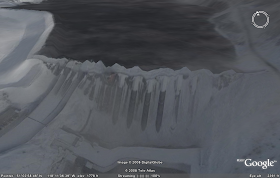Here's an interesting post on design practices for building massively-scalable apps on database infrastructure such as Google BigTable.
The takeaway: this ain't your granpappy's old relational database system, so throw out everything he taught you. Denormalize. Prefer big fluffy things to small granular things. Don't bother with DB constraints - enforce the model in the application. Prefer small frequent updates to large page updates.
The good news (or bad, depending on how fed up you are with your local DBA) - don't bother with all this unless you intend to scale to millions of users.
Tuesday, 24 June 2008
Monday, 23 June 2008
GeoSVG, anyone?
The GeoPDF format seems to be gaining traction these days. I have to admit, when I first heard of this technology I had the same reaction as James Fee - "What's it good for"? But I'm coming round... A live map with rich information content and a true geospatial coordinate system - what's not to like?
My excuse for such scepticism is my finely-honed technical bullsh*t reflex, which uses the logic of "If this is such a good, obvious, simple idea then why hasn't it been implemented ages ago?".
To be fair, there have been lots of SVG mapping demos, which fill the same use case and provide equivalent functionality. Sadly that concept hasn't really caught fire, though (perhaps due to the ongoing SVG "always a bridesmaid, never a bride" conundrum).
Of course, an idea this good is really too important to be bottled up in the murky world of proprietary technology. It seems like this area is ripe for an open standard. SVG is the obvious candidate for the spatial content (sorry, GeoJSON). What it needs is some standards around modelling geospatial coordinate systems and encoding layers of features. It seems like this should be quite doable. The goal would be to standardize the document format so that viewers could easily be developed (either stand-alone, as modules of existing viewers, or as browser-hosted apps). Also, the feature data should be easy to extract from the data file, for use in other applications.
Perhaps there's already an initiative like this out there - if so, I'd love to hear about it.
My excuse for such scepticism is my finely-honed technical bullsh*t reflex, which uses the logic of "If this is such a good, obvious, simple idea then why hasn't it been implemented ages ago?".
To be fair, there have been lots of SVG mapping demos, which fill the same use case and provide equivalent functionality. Sadly that concept hasn't really caught fire, though (perhaps due to the ongoing SVG "always a bridesmaid, never a bride" conundrum).
Of course, an idea this good is really too important to be bottled up in the murky world of proprietary technology. It seems like this area is ripe for an open standard. SVG is the obvious candidate for the spatial content (sorry, GeoJSON). What it needs is some standards around modelling geospatial coordinate systems and encoding layers of features. It seems like this should be quite doable. The goal would be to standardize the document format so that viewers could easily be developed (either stand-alone, as modules of existing viewers, or as browser-hosted apps). Also, the feature data should be easy to extract from the data file, for use in other applications.
Perhaps there's already an initiative like this out there - if so, I'd love to hear about it.
Monday, 2 June 2008
B.C. winter causes frost buckling in Google Earth
The Google Earth imagery of Revelstoke Dam in B.C. (below) looks like it was taken in the depths of winter. Since this is a massive concrete dam, I'm guessing the frost buckling in the image is an artifact of the surface model. Maybe Google need to add some more antifreeze to their TIN algorithm... or perhaps light a twig fire under their rendering engine?

